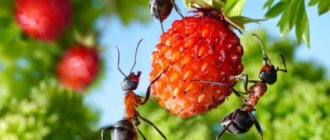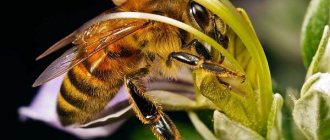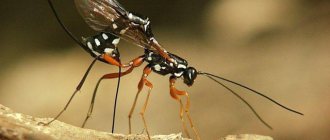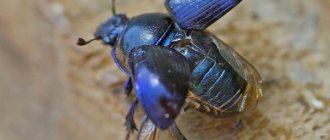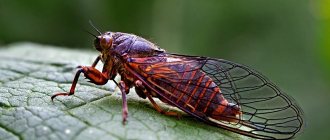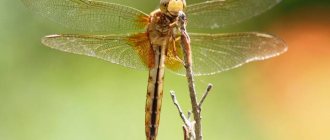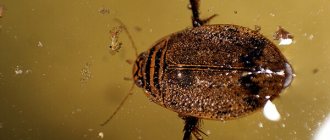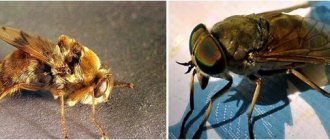Description and features
An ant is a representative of the class of insects, the type of arthropods and the family of ants. These insects live in huge colonies with a clearly defined hierarchy, including division into three groups:
- Uterus
- Males
- Worker ants
Their body consists of a head, torso, three pairs of limbs and antennae, sensitive to external environmental factors, aromas and air currents; in fact, they perform the function of tactile organs. The feet have hooks for easy grip on the surface.
Body size varies from 0.4 to 1.3 cm depending on the species. The queen is usually the largest individual, but may be equal to other members of the community. The color also depends on the variety: red, black, green, etc.
But the presence of wings on the uterus, which die off after the end of the mating period, is found in almost all varieties; some have wings, regardless of gender and place in the community.
The insect has five eyes: two central ones with numerous lenses transmit a blurred image, but allow movement to be recorded; three additional ones have a primitive structure and are located on the top of the head.
The main reference point for ants is smell: with its help they identify members of their community and find food. Special smells are intended to warn of danger and call for help.
To protect against enemies, insects have a sharp sting on their abdomen, with which they can cause serious harm; at the same time, special glands secrete a toxic substance containing a high concentration of acid.
For a person who does not suffer from allergies, it is not dangerous in small quantities; usually the bite site simply turns red and itches. For insects and small animals, the poison poses a mortal threat and can cause severe intoxication.
Why are they together
The civilization of ants is a most interesting object for study and contemplation. Ants are used to living in communities. If you place ants separately and in groups, then those that are left alone will die faster. Where are the ants always in a hurry, where are they running? They are forced to care for the eggs and constantly deal with the larvae. Bee pupae, for example, are each kept in complete rest and strict isolation; ants carry their pupae from place to place even more often than larvae or eggs.
When the ant matures and the time comes for it to hatch from the silk cocoon, it does not leave it itself. The jaws of a young ant are too soft to handle the tough shell. The exit from the cocoon is opened by the older ants, who act as midwives. They cut the cocoon from the outside and help their new brother come out. When males or females emerge into the light, the ants spread their wings that have been compacted in the cocoon. These winged sisters and brothers are fed by worker ants from the first to the last day of their life. Young worker ants receive food from older ones only in the first days. Simply put, the life of the future generation of ants is in the paws of worker ants, so they are constantly fussing.
[]
Kinds
The classification of ants is complicated by the similarity of some species to each other, the appearance of hybrids and twin varieties. With the course of evolution, some genera die out and the survivors resettle, which are forced to adapt to climate change and their usual habitat. The most numerous types of ants :
1. Red ants . The name was given because of the reddish color of the abdomen of females, while males have a black body with a brownish tint to the legs. Ordinary individuals of this species are small - up to 5 mm, the uterus can reach 7 mm.
Red ants are widespread in European countries, the Far East, Siberia and the Urals; they prefer coniferous and mixed forests, in which they play the role of protectors, exterminating pests.
Typically, representatives of the type settle under large stones or fallen trees, but are capable of building an anthill up to 2 meters high with a complex system of passages and numerous exits.
2. Small forest ants . A species of red-brown insects with a black abdomen is listed in the Red Book of many European countries, where it is endangered. Small forest ants are widespread mainly in coniferous forests of Russia, Sweden, Germany, etc. Despite the name of the genus, its representatives reach 14 mm in size and are able to build a dwelling from fallen pine needles about 2.5 meters high.
3. Garden ants . Perhaps the most numerous species, spread throughout Russia, Portugal and Great Britain. The color of the body, covered with microscopic hairs, can be either black or dark brown, but the size varies depending on the social role: queens reach 10 mm, males - 6, working individuals are the smallest - up to 5 mm.
Favorite places to build a house are old stumps and fallen trees. This species feeds on the waste products of aphids, so where these pests exist, you can find many small anthills up to 30 cm high. The peculiarity of black garden ants is the lifespan of the queen: she is capable of reproducing for almost three decades.
4. Pharaoh ants . The variety, named after its place of origin - in Egypt, has spread throughout the world. Individuals are among the smallest in the class and vary in color depending on their role in the community: brownish-yellow females reach 4.5 mm, black males - up to 3.5 mm, and ordinary workers - 2 mm.
It is noteworthy that the males of this species have wings, but in females they grow only during the mating period, after which they are bitten off by worker ants. Pharaoh ants live in human homes and are able to build an anthill almost anywhere - from the foundation of a house to household appliances.
5. Carpenter ants . Settled in forest-steppe zones of Russia and Western Europe. To build a home, they prefer the bark of trees, in which they make many passages, thereby causing damage to forest plantations; they can settle in rotten stumps or wooden buildings. The variety is represented by red ants with a brownish tint to the body, reaching 10 mm in length.
6. Giant ants . The habitat of insects with a bright black body, reaching 33 mm in size, is the humid forests of South America. The variety, in addition to its impressive dimensions, is interesting due to the absence of queens, whose role is taken on by female worker ants during the mating period. Males are larger than females and have permanent wings. Giant insects are underground inhabitants; their anthills are located at a depth of 40 cm and are intended for a small family of 30-40 individuals.
Other common varieties are:
— Ants are bulldogs, named because of their large jaw relative to the body, which allows them to capture prey.
— Ants are nomads who do not have a permanent habitat and create temporary homes and their own bodies.
— Pale-footed ants, so named because of their contrasting color: their body is black and their legs are light brown, the eyes of these insects are unusually large.
— Crazy ants, characterized by chaotic behavior, but capable of creating communities uniting several colonies with a high level of organization and several queens that do not quarrel with each other.
— Honey ants are common in places with arid climates; they store dew and plant juices in their abdomens, which feed all members of the community. Mexicans squeeze honey from these insects, which is considered a delicacy.
- Bullet ants. They are able to deal even with small vertebrates, which they eat as food, cutting them with sharp jaws. They protect themselves by releasing a paralyzing neurotoxin, which causes anaphylactic shock in humans, often resulting in death.
— Soldier ants. The peculiarity of the species is the clear organization of nomadic life activity, division into battalion groups. Due to the fact that the queen reaches 5 centimeters in size when laying eggs, the variety is recognized as the largest known.
- Fire ants. They are dangerous to all living things and are capable of destroying most of the living beings in the territory of their settlement. Despite their size of 4-6 mm, they are extremely aggressive and attack, releasing poison into the victim’s body.
There is an opinion that ants with wings constitute a separate species, but scientists believe otherwise: representatives of many genera, both female and male, have temporary or permanent wings. They serve for convenient movement to the habitat of other families and the formation of new colonies.
Red ant
One of the most common types of wood ants are red ants. They are quite large in size - 4-9 millimeters. The head and chest of these ants are orange, and the abdomen and back of the head are black.
The red wood ant is one of the most common species.
Red ants build huge nests that can reach up to 2 meters in height. They build anthills from soil and food scraps. Female red ants do not leave their nests and do not form separate colonies; they replace the old female when she dies.
Lifestyle and habitat
Due to the large number of species, the life of ants influences biogenesis. By creating anthills, they actively loosen the soil, saturating the roots of plants with air and moisture. Inside houses there is a warm and humid atmosphere in which bacteria actively multiply, processing waste products and excrement. Thus, insects help saturate the soil with nutrients.
The ant is a social insect, the structure of their communities is similar to that of humans, characterized by a clear structure in which the distribution of roles plays a vital role. Some species, in addition to the three main castes, have an additional one - soldiers, they serve as protectors of the anthill, for this the workers provide them with food.
A special variety of insects, fire ants , subjugate representatives of weaker families and parasitize at their expense. In any case, the anthill is a single organism, without which individual individuals cannot survive.
Ants have settled across all continents and climatic zones with the exception of deserts, Antarctica and the cold islands of the Atlantic and Arctic oceans. Each species has its own habitat, but ants are able to move even between countries and continents, forming new colonies where they were not previously settled.
At the same time, stronger varieties are able to displace weaker ones from their usual places. Life in a warm climate allows insects to reach impressive sizes for the family and continue their life activities year-round; ants in temperate and cold zones are much smaller and hibernate in the winter.
Most species organize their homes in the form of anthills; these can be earthen dwellings, settlements in tree bark or rotten stumps; special species are able to capture bird nests and settle in them.
Ants are measured by size... or an overview of colonies. Video (00:05:32)
At the same time, different types of ants are nearby. You can compare the size and color of ants in one video.
Ants in the video: Black Garden (Lasius niger) Steppe Reaper (Messor Structor) Steppe Runner (Cataglyphis aenescens) Red Jet (Camponotus nicobarensis) Black Woodborer (Camponotus vagus) Camponotus fellah
An ant farm is an excellent gift for a child; it will take him away from the computer or game console and captivate him with observations of the existence of a very interesting micro-people. Also, this is an excellent opportunity to make sure whether your child will take care of pets.
and captivate him with observations of the existence of a very interesting micro-people. Also, this is an excellent opportunity to make sure whether your child will take care of pets.
In addition, the formicarium will allow for a number of studies and experiments, and will also lift the curtain of secrecy about the processes occurring in real anthills.
After purchasing the kit, you will not need to regularly spend money on maintaining the anthill; the costs will be rare and very small. An ant farm is very economical in this regard, despite the hefty start-up costs.
Nutrition
Ants are one of those insects that can eat whatever they find. The main difference between their diet is the lack of fat. Depending on the age, the needs change: for harmonious development, the larvae need protein, which they receive from invertebrates: caterpillars, butterflies, worms.
Ants are also capable of attacking small animals, if they are weak or wounded, and do not disdain carrion. The ant in the photo is dragging into its home a caterpillar whose size is larger than its own.
Adults, especially workers, need carbohydrates that provide energy. A large amount of them is contained in honeydew, secreted by plants, and honeydew, which is a waste product of small insects, such as aphids.
Garden ants are indiscriminate in their food and eat both sweet berries and small insects. Woodworms eat the decay of the stumps in which they live. A special intestinal bacterium characteristic of this species helps digest it.
Cannibal ants are also known to feed on weaker individuals of their species or suck some of the nutrients from the larvae without harming them. Domestic insects that settle near humans eat everything that humans leave behind: from grains of sugar to vegetable oil.
Interesting facts about ants
- The bullet ant, which lives in tropical conditions, can bite by injecting a fairly potent poison that causes pain in the victim, which is several times greater than the sensation of a bee or wasp sting. Indian tribes who know this teach their younger generation to be resistant to severe pain. To do this, they place the boy's hand in a plastic bag with these insects. As a result of numerous bites of these insects, the hand begins to swell, and the person feels incredible pain.
- Ant eggs are nothing more than larvae, and some tribes in Africa and residents of other Asian countries have no problem including them in their diet. Many believe that larvae contain a lot of protein, and plus, eating them increases potency. Mexicans generally spread these eggs on corn tortillas and eat them with pleasure on holidays, like many nationalities eat red caviar.
- The queen, on which the life of the colony depends, can live for about 6 years. Moreover, there is evidence that the queen was able to live for as long as 14 years, which is an absolute record for the insect order.
Reproduction and lifespan
The lifespan of ants depends on their species and the social stratum to which they belong. In most families, roles are assigned from the moment of birth, in some families they change over time. The size of the individuals is also important: the larger they are, the longer they can live. The female usually survives and remains capable of reproducing much longer than the males and worker ants.
Pharaoh ants have the shortest life expectancy: males live no more than 20 days, workers - up to 2 months, females - up to 9 months. Tropical species are recognized as long-lived; their queen can live up to 30 years, and workers up to 6. Ants reproduce several times throughout the year in two different ways:
- The queen, together with several dozen working ants, forms a separate home, separating from the base of the family.
- The female is fertilized by males from another anthill, flying on temporarily growing wings.
In any case, the queen lays eggs, some of which remain unfertilized. Males emerge from them; if the egg is fertilized, it will give birth to other females and worker ants. The photo shows a queen and several workers caring for the larvae.
Queen of Ants
The queen of the ants is the queen, a sexually mature female.
She needs wings, in fact, only to find a male. Males and females of ants fly quite poorly. Ants are not able to fly directly from the ground. They rise gradually, first flying onto blades of grass, then onto branches of bushes, then trees, and only then, from a sufficient height, they begin to fly. However, some drones are capable of taking off directly from the ground. After fertilization, the female sheds her wings - she no longer needs them. The queen is capable of founding a new anthill. To do this, she digs out a small underground corridor, where she subsequently lays eggs. Sometimes several females organize a colony at once. After this, a difficult period begins in the life of the uterus. Until her daughters grow up, she has to starve while feeding the larvae. But when the first workers appear, she will begin to live like a real queen: her daughters will provide her with a well-fed existence. By the way, it is interesting that males hatch from unfertilized eggs.
The benefits and harms of ants
The benefits and harm from insects depend on how large their family is and where they live: on a personal plot or in a forest. Garden ants contribute to the enrichment of the soil with oxygen, as they dig their tunnels in the upper layers of the soil.
Humus and remains of organic waste carried by ants into their homes decompose over time, saturating the soil with minerals and making it more fertile. Insects are also plant pollinators: while obtaining nectar for food, they transfer pollen on their abdomens.
Unfortunately, ants contribute to the proliferation of aphids, since they feed on the products of their vital activity, therefore, where there are many of these insects, aphids also live freely, causing enormous damage to the crop.
At the same time, they are capable of exterminating caterpillars and some types of butterfly pests. If ants appear in a human home, they not only cause discomfort, but also eat food, spreading infections and causing allergic reactions.
Forest ants protect trees from parasites, destroying huge populations of them. In addition, by collecting the secretions of certain insects, they protect plants from fungal diseases. But the woodborer is capable of destroying a healthy tree in just a few weeks, making tunnels in its trunk.
This species is also dangerous for garden furniture made of solid wood, since neither paint coating nor pungent-smelling products for treating wood products can scare them away.
Ants secrete a special secretion called formic acid; it is widely used in medicine and pharmacology, and is included in antiseptics, drugs to combat the development of diabetes, arthritis, etc.
If the acid enters the human body in its pure form, it can cause severe anaphylactic shock, which, without timely administration of antihistamines, leads to death.
Stages of building an anthill
The construction of an ant house begins with the appearance of the sexually mature generation. Under favorable conditions, the queen (queen) lays ant eggs. Subsequently, the workers take care of them. Sexually mature females and males leave their anthill to build a new colony and reproduce.
It is interesting to watch how ants build an anthill. First, they find and carefully examine a site for a new home. It is important for them that there are no dead ants in the selected area; it is advisable that there be “hunted” prey there (a large caterpillar, a frog, a beetle, a pile of sugar, seeds and mushrooms). The place should be in the shade, have normal humidity and ventilation.
Ants build a common house from various blades of grass, leaves, earth, and bark. The building material is carefully crushed and glued together with ant glue. The work is carried out very carefully and thoroughly, for centuries. Construction continues around the clock as the ant colony grows rapidly. Almost all their lives, these hard workers build their home, increasing it both in depth and height.
How to get rid of ants
Given the huge population of insects and their ability to reproduce, fighting them, as a rule, brings only temporary results. The most effective in killing insects are those based on diazinon and chlorpyrifos.
The first has a nerve-paralytic effect on ants, leads to their death and remains effective for 2-3 weeks. The second one paralyzes the respiratory system and remains effective for up to 2 months. Popular means for controlling insects in a summer cottage:
- "Absolute"
- "A great warrior"
- "Ant-eater"
- "Thunder"
- "Medvetox" and others.
Traditional methods of getting rid of ants:
- Smells. Insects are extremely susceptible to unpleasant odors, so a great way to drive them away is to place strong-smelling herbs (anise, wormwood, sage) or food scraps (herring, garlic, tomato leaves) near the anthill. The cardinal method will be kerosene - they need to water the insects' home, but do not set it on fire.
- Hunting belts. If ants cause damage to trees, the trunks should be wrapped in foil or polyethylene with foam rubber placed inside at a distance of 30-40 cm from the ground.
- Moisture. Insects do not like water, so plants need to be surrounded by holes that regularly receive large amounts of water. If the anthill has already been built, it can be poured with boiling water in several stages; a more humane way is to pour cold water in large volumes.
- Yeast. Add a little honey, sugar and water to the package of yeast. Distribute the gruel into matchboxes and place them near the ants’ homes; soon they will be abandoned by them.
- Lime and carboxylic acid. Mix the substances in equal proportions and treat the trunks of trees and large shrubs.
Small populations of ants located in the garden are unlikely to cause damage to the crop, but will protect it from pests. If there are several anthills and they are quite large, measures should be taken. Despite the usefulness of these insects, being around them is not only unpleasant, but can also become dangerous for humans, especially if there are small children in the house.
Interesting life inside an anthill
Ants live in large colonies that persist for several years. All members of such a colony are relatives. From a social point of view, an anthill for ants can be considered a city, the population of which is divided into castes and is perfectly organized. Experts believe that a parallel civilization is developing under our feet.
If people interact through speech, facial expressions and gestures, then ants communicate by exchanging food and using smells: each ant has a unique smell, and each colony has special shades of aromas. Thanks to them, insects can sense that a stranger has entered their home. In addition, ants interact using pheromones. This is how they inform their relatives about danger or the place where food is located.
Spreading
The habitat is located in the Palearctic. It occupies predominantly the northern regions of Europe and Asia, including Eastern Siberia, Transbaikalia and Mongolia.
Black garden ants were introduced to the northwestern United States. They have now settled throughout the southern regions of Alaska and Canada and most of the northern states of the United States. The southern border of the range stretches along the Rocky Mountains, Sierra Nevada and Appalachian mountain ranges. In Africa, relatively small populations live in Algeria.
The eastern border of the range runs along the banks of the Bodonch River in western Mongolia near the southern coast of Lake Baikal.
Insects prefer to settle in open forests, on the outskirts of forests and meadows. They are often found near human habitation in gardens and parks.
Types of ants
Today there are a huge number of species of these insects. Some of them are so similar to each other that only a specialist can determine exactly what genus this representative is. Let's look at the types of ants.
Forest
The forest variety prefers forests where a temperate climate prevails. This species is widespread throughout the Euro-Asian continent.
Main characteristics of forest inhabitants:
- Red-brown body color, reddish cheeks, black belly.
- They reach from 7 to 15 mm in length.
- In forests they build large nests, which can be up to 2 m in height. Branches with pine needles are used as building material.
The species is listed as endangered. Rare in some regions.
Meadow
The species is highly resistant to cold. Meadow ants prefer forest areas in the temperate latitudes of Eurasia (almost the entire territory of Europe, most of the Russian Federation).
Main characteristics of meadow ants:
- The color is red, there is a black spot on the chest, the body is covered with elastic hairs, but they are absent in females.
- They grow from 6 to 13 mm in length.
- They prefer to settle on the edges, meadows and clearings. The anthill is loose, with a diameter of about 3 m at the base. The dome looks like a slightly flattened cone. Large plant remains sprinkled with sand are used as construction material.
- Up to 70,000 insects live in one nest.
Eastern Liometopum
It is considered a species that is in danger of extinction, since it is listed in the Red Book, while it is an inhabitant of the Far East. Working individuals are dark brown in color and measure about 6 mm in length. Males and females are almost black and grow to 10 and 12 mm in length respectively. They build their nests in Korean pine, fir, Mongolian oak, linden, birch, etc.
Pale-footed ants
A species of garden ant, also included in the genus Lasius, is the pale-legged ant. These insects live in Europe and the Caucasus. The size of working individuals is 2–4 mm, the queens reach 9 mm. The body color of the pale ant is light to dark brown. A distinctive feature of this species is its large eyes.
The pale-footed ant is similar to the common garden ant, differing in light-colored limbs
These ants prefer to live in dry, open areas, usually on lawns. They can also build homes under stones or paving slabs. A nest on the surface of the earth can be identified by a small crater.
Pale-legged ants are also called pale garden ants or light brown lasias.
Pale garden ants are not dangerous to humans, but they can harm the garden. The majority of their diet consists of insects, including other pests. But in the summer, as a result of digging up the lawn by ants, the grass and flowers can dry out. However, such consequences only occur when there are a very large number of pale-legged ants in the area. Just like black garden ants, pale-legged ants breed mealybugs and aphids, which harm the garden.
Dinoponera gigantea
This representative received special fame due to its gigantic size. Individuals of this species are capable of reaching about 33 millimeters in body length. Their bodies are painted black. Males are distinguished by the presence of wings, but the queens of this species do not exist at all. Instead, they use working individuals - females. These large ants are found only in humid forests and savannas of South America. They make their home at a depth of about 40 centimeters.
Ant bullet
The bullet ant causes one of the most painful bites in the insect world. Victims compare the pain they experience to a gunshot wound. To make matters worse, its bite causes suffering for 12 hours.
Stray Ants
Stray ants are constantly migrating, hence the name. When food runs out in a certain area, the insects line up in a column. Nomadic ants move every week; they do not have a permanent place of residence. At each rest stop, the workers build a temporary nest with their bodies, where the queen produces more than 20,000 eggs in a week. When moving in a column, nomadic ants carry eggs and larvae in the middle, with soldier ants on the sides. During the hike, insects actively hunt.
Black garden ants
Widely distributed in gardens. Quite small (3-5 mm) and black in color. Colonies number up to 70 thousand individuals. The anthills are underground, with only a small mound remaining at the top. Sometimes they make their homes in rotten trees or under stones. They are considered pests in the garden because... promote the spread of aphids and scale insects. They feed on honeydew and the remains of dead insects, as well as live insects. The bites are not dangerous, but are painful and can cause an allergic reaction.
Black garden ant
Despite all the diversity of species, their body structure is the same. The body consists of three segments - head, thorax and abdomen. There are antennae and three pairs of legs, and some species have a stinger and wings. They always live in ant families, forming nests. The home is built near trees, under stones, in the soil. Depending on the species, the number of ant families can reach several million individuals.
Reaper Ants
They often live in hot, dry climates. The color is black, body length is from 4 to 15 mm. The colony consists of about 5 thousand individuals. Anthills are built underground, and a small mound is visible on the surface. They feed on dry plant fruits, grains and seeds that have fallen to the ground, so they do not harm plantings. Popular for breeding in home ant farms or formicariums.
Reaper Ant
Fire ants
Fire ants are the most dangerous insects of their genus.
It has a sting hidden in its abdomen, with strong poison. Insects feed on protein and plant foods. Fire ants, in addition to insects, caterpillars and larvae, are capable of hunting small mammals, sometimes amphibians. For this case, the insects gather in a group and climb up the victim’s legs, digging into the body together. When fire ants, in large numbers, inject a toxic substance, the animal can become poisoned and die within a few hours.
Fire ants can attack people while protecting their home; their bite causes pain and burns, and in some cases leads to death. This type of insect often makes nests in human homes. These are the most dangerous insects, called cannibal ants. In some countries, entire villages had to move due to the invasion of these pests.
The largest ant in the world is African, the size of its uterus reaches 6 cm. The next largest ant species is the bulldog. Description: Working class - 2 cm, males 16-18 mm, soldiers - 26-28 mm, queen - 30-33 mm.
Pharaoh ants
Initially they lived in India, but moved to Russia with the help of ships. The color is yellowish or red, the length of the body is 1.5-3 mm. The color of the uterus is slightly darker, the length of the body is up to 4 mm. The family includes several thousand individuals. They do not have anthills in the usual sense of the word; they live in diffuse nests. They love to settle in a person’s home, which causes a lot of inconvenience. It is difficult to remove them, because... It is necessary to treat all habitats in the house with insecticides. They feed on leftover food, less often on skin and fur. Because Individuals of this species run through unsanitary places and often carry dangerous infections. They do not bite painfully, but a bite on the skin creates conditions for pathogenic bacteria to penetrate the skin, and sometimes causes irritation and an allergic reaction.
Pharaoh ant
As a pest
In the garden
This type of ant is a problem for some gardeners. They will cultivate aphids and scale for the honeydew they excrete, causing them from the host plant to host the plant and spread these other garden pests to new healthy plants. Ants also eat ripe fruits, especially fruits such as strawberries that do not have a thick protective shell. Lasius Nigeria
also feed on insects and spiders, and other small invertebrates.
At home
Black garden ants often explore their surroundings quite widely during the early summer months in order to increase food supplies for their queen and her young, and as a way of testing out new ground in preparation for summer nest flight. In some cases, these investigations lead to digging through a mortar and brick.
Where live
These tiny workers are widespread on all continents, with the only exception being Antarctica. Insects live in anthills that they build themselves. The founders of such nests are females (queens), whose function is not only to procreate, but also to select a suitable place. Each colony has only one queen. All the other inhabitants of the anthill feed and protect her. A photo of the anthill where the ants live can be seen below.
Anthills
Interesting!
Male ants die almost immediately after mating with a female. Worker ants, or foragers as they are also called, take care of the rest of their family by delivering food to them. Another function of worker ants is to protect the anthill from attack by enemies.
However, not all types of ants are clearly divided into castes. So black garden representatives devote the beginning of their lives to caring for eggs and larvae, in the next stage of their life they build a nest, and later their function is to obtain food. As a result, the anthill contains the largest number of living individuals.
Control measures
Preventive actions
Compliance with sanitary and hygienic rules for maintaining premises:
- Compliance with the rules of personal hygiene, sanitary standards in residential and industrial premises and common areas;
- Timely removal of various food waste and garbage
Compliance with sanitary measures:
Creating conditions in the premises that do not allow ants to enter and interfere with their life activities.
Exterminatory pest control
- Use of food insecticidal baits (for example, in the form of gels); it is preferable to use intestinal insecticides from the group of organophosphorus compounds, phenylpyrazoles, pyrethroids and other substances;
- Timely application of insecticides from the group of organophosphorus compounds to the soil, places of accumulation, and anthills.
Organization of an ant colony
For a long time, insects were considered extremely primitive creatures, but this is not so. They create highly developed communities. These insects are extremely small in size, but thanks to the amazing connection between all members of the colony, they work as a single organism. Now there is more data about how ants live. However, their study continues.
As a rule, ants build stationary houses, but there are also nomadic species of insects that build temporary huts from their own bodies by interlocking their jaws and legs. In such dwellings, the female, ant eggs and larvae, as well as numerous workers remain for several weeks, and then the entire colony moves on in search of food.
The construction of a stationary anthill begins with the birth of a sexually mature generation. When favorable conditions are created, the queen produces special ant eggs. This generation is then looked after by workers. Sexually mature males and females leave their natal nest to begin reproducing and building a new colony.
Hundreds of new anthills can be founded in one season. After the female leaves the birth nest, she mates. The resulting material will be enough for her to produce offspring throughout her life. After mating, the female becomes queen. She immediately begins to prepare to take her place in the hierarchy, so she looks for a small hole or digs one herself. In it she lays her first offspring.
queen ant
All members of the ant community have different life expectancies. For example, depending on the species, males live from 2 to 14 days. The queen ant is a true long-liver in the insect world. The average lifespan of females is 15 to 20 years. The queen, having found a secluded corner, immediately lays a significant number of eggs. Asexual members of a new colony usually live between 1 and 3 years.
Dimensions and features of anthills
From a scientific point of view, an anthill is a nest in which a colony of ants lives. This refers not only to the part visible from the outside, but also to the underground part. Insects can also build several nests, with many paths running between them. They are also taken for one anthill.
Weaver ants nest
Nests can have all sorts of sizes - it all depends on the type of ants, as well as the area in which they live. For example, members of small genera such as Leptothorax and Temnothorax build acorn-sized homes. Large forest ants of the genus Formica require huge nests up to 2 m.
The lifespan of an anthill is also unlimited. As a rule, insects can use a nest from several to hundreds of years. The complexity of the design is determined by the lifestyle of the colony. Most ants create elaborate homes that they will inhabit for many years. Nomadic species do not need complex nests - after a couple of months of sedentary life, they migrate to a new place.
Interesting fact: the nomadic African species Dorylus wilverthi is known for the largest colonies - about 22 million individuals. Ants move for several days at a speed of 20 m per hour. The stay in the underground nest lasts no longer than 3 months, during which the foragers replenish food supplies daily
Carpenter ants live in tree cavities
Nests are built underground and outside, in trees, logs, etc. The materials used are soil, various plants, leaves, and pine needles. Weaver ants strengthen their homes with webs. When darkness falls, the exits from the nests are covered with resin to prevent heat loss. Nests can go several meters underground.
